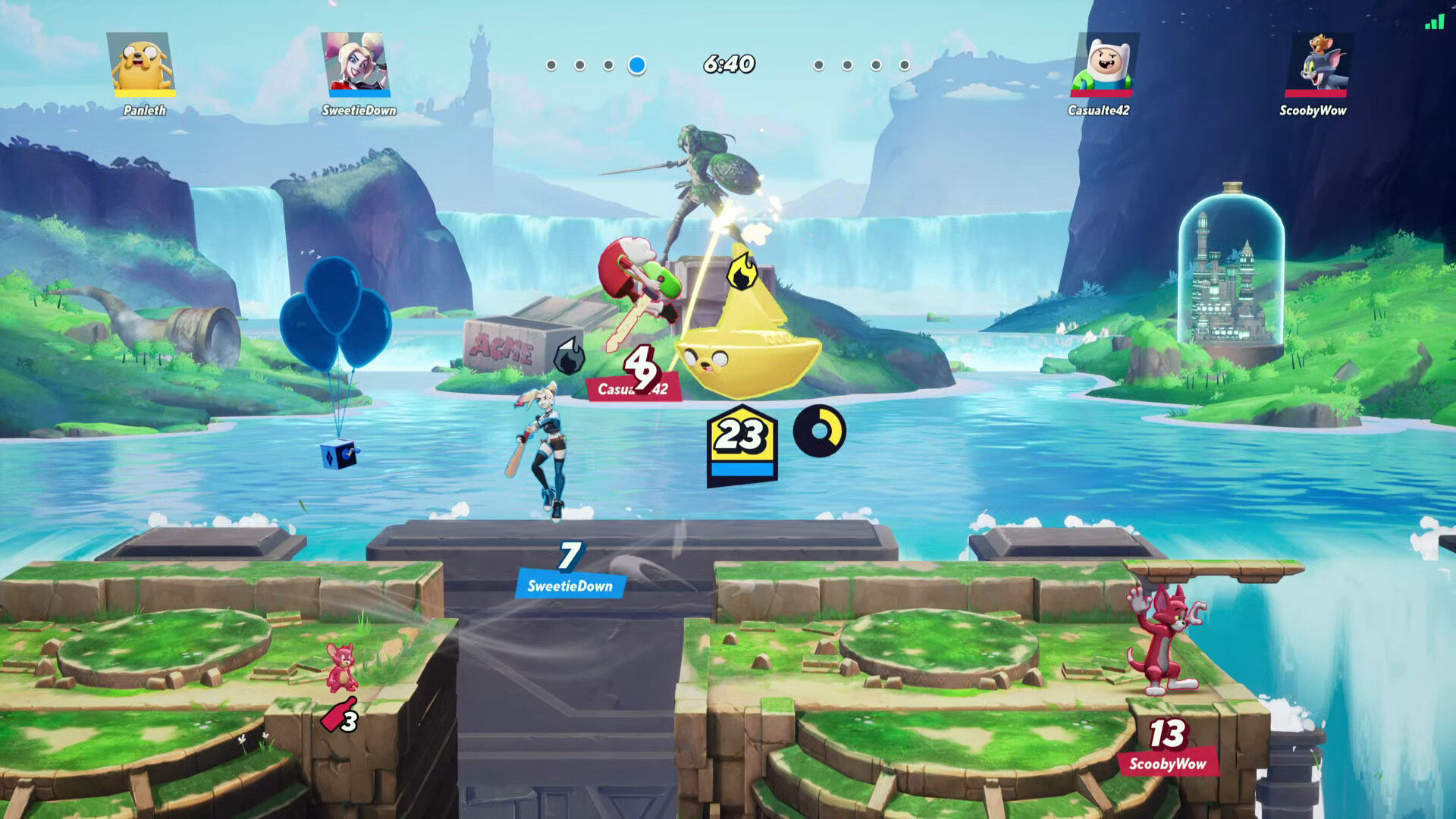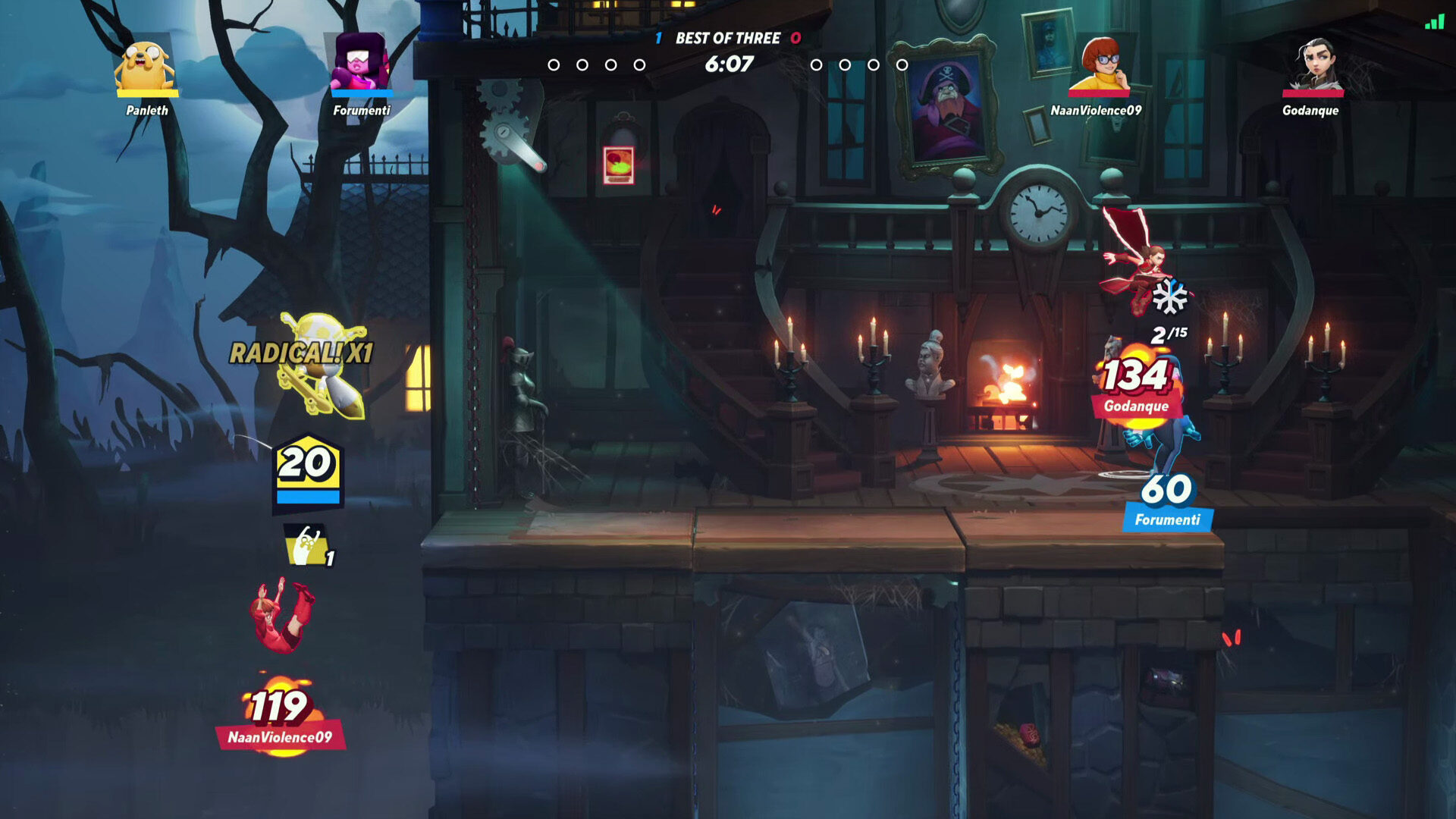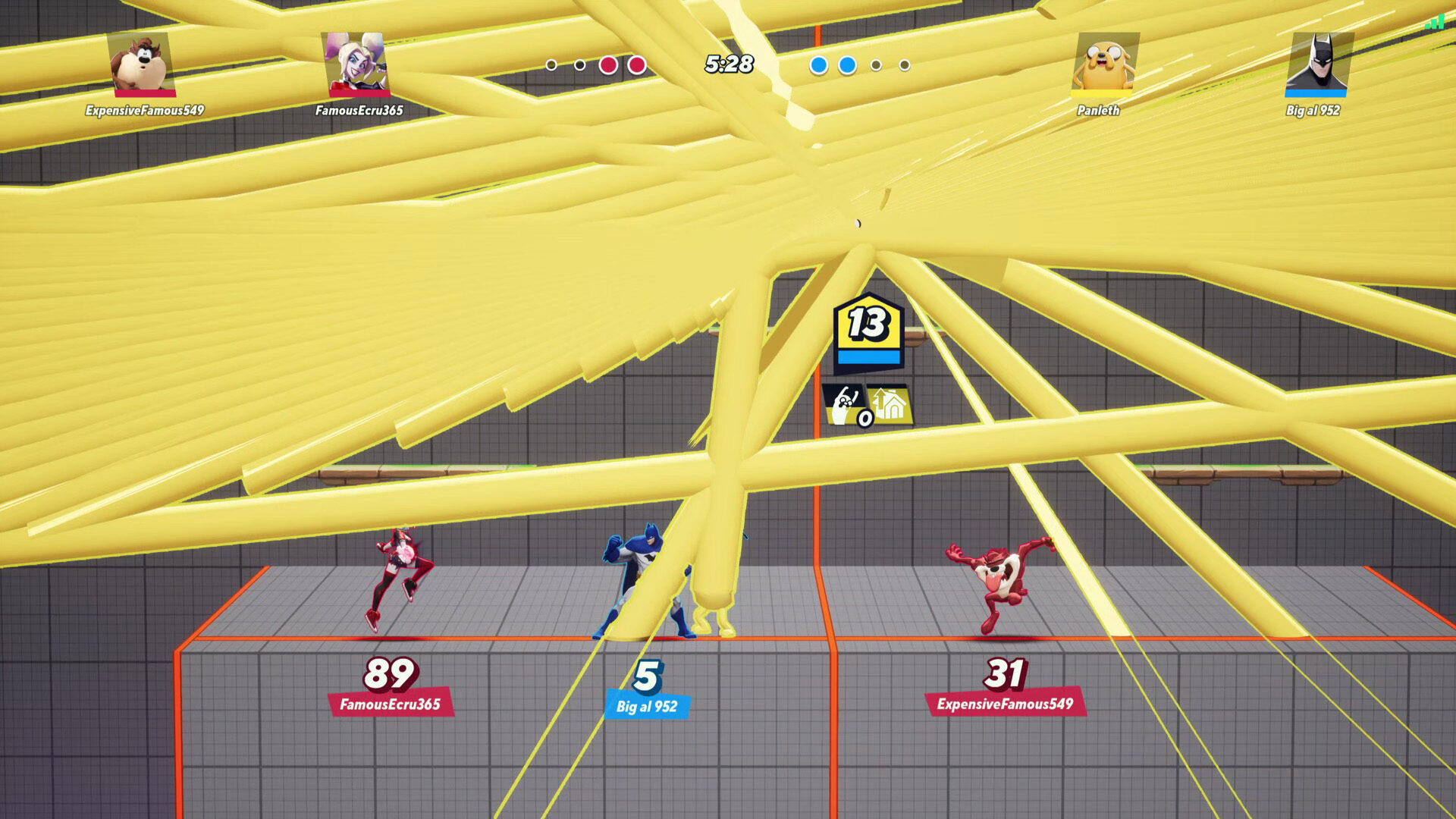MultiVersus is a lot.
I mean that in the obvious sense—the Bugs Bunny and Arya Stark beating up Shaggy and Steven Universe inside the Batcave sense—but I’m also talking about the less blatant design choices in its gameplay.
In trying to put its own spin on the so-called “platform fighter” formula first introduced by Nintendo’s Super Smash Bros. series, developer Player First Games has clearly thought about the many different approaches that might help a new title in the genre stand out. Do you emphasize technical skill, hoping to cater to the Melee crowd? Do you focus on seamlessness and approachability to match your (mostly) kid-friendly characters? Do you stick with the tried-and-true core mechanics, or do you try to innovate?
Rather than picking a lane, MultiVersus swerves all over the freeway. It oscillates between the frequencies of “refreshingly simple” and “I need a PhD.” At times, it feels like it was made from a recipe that only had one word written under ingredients: yes. This is a game that can only be spoken of properly through mixed metaphors.
If I’m making it sound awful, trust me when I say it’s not, at least not so far. I actually had a great deal of fun during my hands-on time with the game’s closed alpha, during which I played around 75 matches and tried out each of the 15 playable characters at least briefly.
But Player First’s cioppino philosophy toward gameplay makes for an experience that defies easy distillation. (Please do not attempt to distill cioppino; my metaphors have mixed too far.) It’s going to take a bit to walk you through everything MultiVersus does to make it more than just a brainless Smash clone, so strap in.

The basics, of course, are pretty recognizable. You pick a character mined from the rich, sweet vein of Warner Bros. intellectual property and duke it out against other players on a variety of stages with one or more platforms over an open pit. Characters have standard attacks and special attacks based on how they fight or behave in their native media. Landing hits (or getting hit) raises a damage counter, which makes your competitors (or you) easier to knock around the map. The only way to eliminate another player is by knocking them off the side (or top or bottom) of the screen. So, to recap: Hit people to make them easier to send flying, keep hitting them until they fly far enough.
Simple enough, and it works pretty well on the pick-up-and-play, Smash Bros. level. The controls in MultiVersus feel sufficiently tight, and the attacks are creatively varied within and between characters to allow you to set up simple, satisfying combos.
But then, on top of that, MultiVersus wants to emphasize teamwork. So the main mode it recommends is 2v2 (though there’s also 1v1 and a four-player free-for-all), with the first team to notch four eliminations winning the match. To make co-op more meaningful, certain characters have specials that can buff your teammate. Example 1: Superman’s ice breath can temporarily give his ally ice gauntlets. Example 2: Reindog (original character, do not steal) can attach an energy tether to its teammate and reel them back in if they’re falling into the void.
On top of that, there’s also a perk system. You can assign up to three modifiers to your characters. Three of these are relatively simple, if sometimes oddly specific—things like +4% move speed or +5% melee damage while in the air. If you and your teammate equip the same perk, the effect will be amplified (but not always doubled). Oh, and you have to unlock these perks by leveling up each character individually with an XP system. And eventually you unlock the ability to spend currency to unlock perks that aren’t native to your character. But anyway, back to the fourth perk. This is a special slot reserved for “Signature Perks,” which modify one of your attacks. Batman, for instance, has the “Bouncerang” perk, which means “hitting an enemy with the Batarang while it is returning to Batman will apply maximum stacks of weakened debuff.”

Oh, did I not mention there are debuffs and buffs? Yeah, there are a load of status effects that can be applied with your attacks, often by stacking them with a sufficient number of hits before the counter decays. Taz even has a debuff that turns an opponent into a large roast chicken, unable to attack until the effect wears off, and Taz can tear off pieces of meat by attacking and then eat them to restore his health.
In fact, a lot of the characters have some gimmicky element like that, usually tied to a passive ability. If I’m counting very broadly, 11 out of the 15 characters in the alpha have some kind of gimmick that goes beyond simply learning their attacks and landing them successfully. If I count as narrowly as possible, that number drops to 5 out of 15—still a full third of the roster.
And some of these gimmicks are, to quote Shaggy, like, super out there, man. Here’s the actual in-game text for Velma’s passive ability, Snoopin’:
During the match, EVIDENCE will appear, and some of Velma’s moves will spawn EVIDENCE. Velma and her ally can pick up EVIDENCE to fill up her EVIDENCE METER. When the meter is full, Velma can call a POLICE CAR. The POLICE CAR will drive and pick up the nearest enemy, revealing it was really Old Man Jenkins, then STUN them and drive away. The other enemy teammate can attack the car to try and release their teammate. Velma can also move while crouching.
Look, I’m sure you got the picture several paragraphs ago. I haven’t even mentioned that there are ability cooldowns—but only for some attacks, and not even exclusively special attacks, and sometimes your Signature modifier will have a cooldown but the actual attack won’t. I didn’t bring up the armor system (and armor break system), or the simple but skill-ceiling-raising movement tech Player First has incorporated. I haven’t touched on the battle pass and daily challenges and games-as-a-service stuff, which is hardly surprising in a modern free-to-play game but still represents an added layer of Things To Keep Track Of.
In light of all that general busyness, perhaps the most remarkable thing I can say about MultiVersus is that it’s not inherently overwhelming while playing. I gravitated toward a character with no gimmick of any kind, Jake, the stretchy dog from Adventure Time, quickly got a handle on how best to use his basic move set, and never felt like I had to fiddle with my perks to stay competitive. The matches are fast and sometimes difficult to follow, and there’s a lot of general UI noise in the interest of transparency, but it’s not total chaos. There might even be a great, addictive brawler buried under all the half-cruft.
All that being said, I do have one big concern I’d like to end on: the servers. Since the game is still in closed alpha, I don’t want to make too big a deal out of this just yet. But it’s worth noting that the not-infrequent lag I encountered—better but not gone once I plugged in my PS5 over ethernet—can really make things less predictable than they should be. Opponents will seem to run off one edge of the platform, and then teleport to the other side of the stage. You’ll think you’ve dodged an attack, only to have it retroactively connect and send you flying to your doom.
In one particularly memorable instance, I used Jake’s up-special, which stretches his head out from his legs and then pulls his butt up to meet it, just as the game began to lag.
Suddenly, I gazed into the infinite. A longdog belly streaked itself across the stage dozens of times at dozens of angles, painting a bus-yellow canine mandala. My eye turned inward, forced to contemplate the universe—nay, the multiverse. We are all intellectual property. We are all the Warner Brothers.

Anyway, here’s hoping Player First can fix that—or turn it into a dope new passive ability—before MultiVersus releases this July on PlayStation 5, Xbox Series X/S, PlayStation 4, and Windows PC.
